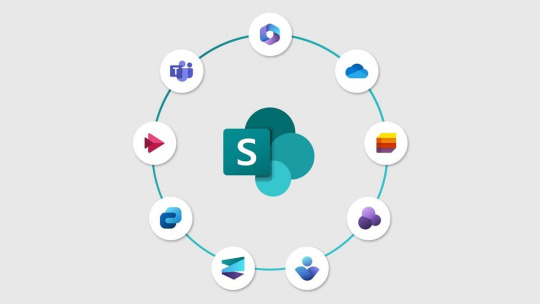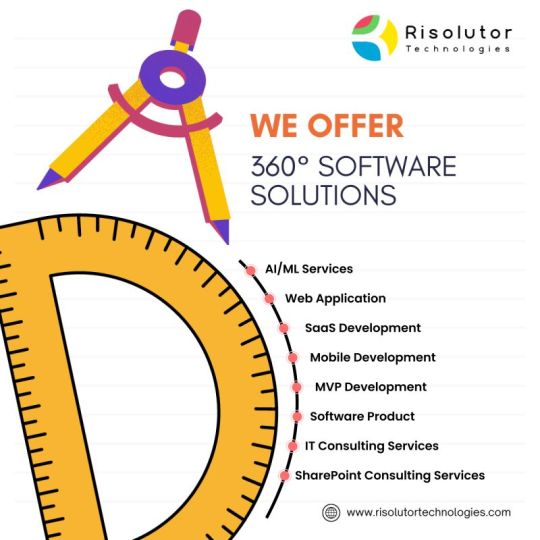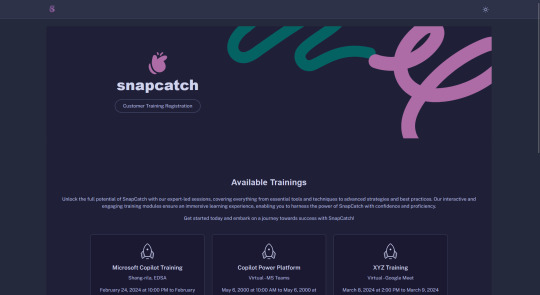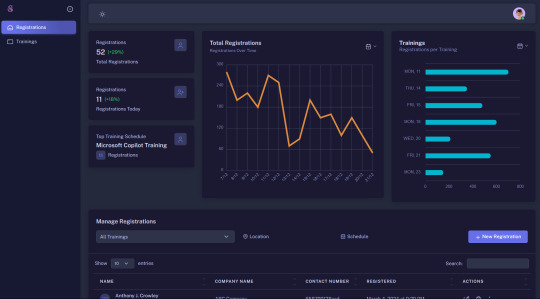#Custom Sharepoint Development
Explore tagged Tumblr posts
Text
Custom SharePoint Development vs. Out-of-the-Box Solutions: Which Is Right for You?
Find out if a tailored SharePoint experience or a standard solution better suits your organization’s needs.

#custom SharePoint development#hire sharepoint developer#sharepoint development company in usa#sharepoint development services#sharepoint development#sharepoint application development services
0 notes
Text
From Concept to Launch: How SharePoint Application Development Works

In the modern business environment, efficiency, collaboration, and streamlined operations are more crucial than ever. Organizations increasingly rely on digital platforms to centralize processes, manage content, and enhance productivity. Among these platforms, Microsoft SharePoint stands out—not just as a content management system but as a powerful application development framework.
With custom SharePoint application development, businesses can build tailored solutions that fit unique workflows, automate routine tasks, and seamlessly integrate with other Microsoft 365 tools. But how does it work? What’s involved in transforming an idea into a fully functional SharePoint app?
In this article, we walk you through the complete journey—from concept to launch—of developing a SharePoint application, and how this process delivers scalable, secure, and user-centric digital solutions.
Why Build a SharePoint Application?
Before diving into the process, let’s look at why businesses choose SharePoint for application development:
It’s already part of the Microsoft 365 ecosystem.
SharePoint supports custom forms, lists, workflows, and integrations.
Apps are available on mobile devices and the internet.
You benefit from Microsoft’s enterprise-level security and compliance features.
It supports both low-code/no-code and full-code development models.
Whether you’re building an HR onboarding portal, ticketing system, contract management tool, or a project tracking app, SharePoint offers a flexible and robust foundation.
Step 1: Defining the Vision (Concept Phase)
Every successful SharePoint application begins with a clear vision and business need. The concept phase involves identifying the problem you want to solve and understanding the users.
Key activities:
Stakeholder interviews and requirements gathering
Reviewing current pain points or inefficiencies
Defining goals and desired outcomes
Documenting essential features and user roles
Example:
A finance team needs a custom expense approval app to eliminate back-and-forth emails and spreadsheets. The concept might include role-based permissions (employee, manager, finance), automated notifications, and integration with Outlook and Excel.
Step 2: Feasibility Analysis and Planning
After the idea is obvious, the following step is to determine its viability and create a development roadmap. This includes technical, functional, and operational planning.
Key activities:
Platform choice (SharePoint Online, on-premises, hybrid)
Evaluating the existing SharePoint environment's readiness
Timeline and resource planning
Choosing between Power Platform tools (like Power Apps, Power Automate) vs. SPFx (SharePoint Framework) for custom coding
Deliverables:
Project scope document
Functional specifications
Wireframes or mockups
Tech stack selection (JavaScript, REST API, Graph API, etc.)
Planning is critical—skipping this step can lead to feature creep, budget overruns, or misaligned outcomes.
Step 3: Designing the User Experience (UX/UI Design)
SharePoint apps are used daily by employees, so intuitive design and usability matter. In this phase, designers work to create a user interface that is both efficient and engaging.
Key activities:
Designing user-friendly navigation and layouts
Creating responsive designs (desktop/tablet/mobile)
Aligning UI with corporate branding
Ensuring accessibility and ease of use
Tools Used:
Figma, Adobe XD (for design)
SharePoint modern site pages or SPFx for front-end development
Office UI Fabric or Fluent UI libraries
A well-designed SharePoint app reduces training time and improves adoption rates across the organization.
Step 4: Development and Integration
Now, the actual SharePoint application development begins. Depending on your needs, developers may build custom components or use Microsoft’s low-code tools for faster deployment.
Development approaches:
Low-Code Development:
Power Apps for custom forms and interfaces
Power Automate for workflow automation
SharePoint Lists for data storage
Custom Development (SPFx):
SPFx web parts and extensions
Custom APIs using Azure Functions
Integration with Microsoft Graph, Teams, Outlook, etc.
Key functions typically built:
Forms for data entry and updates
Automated workflows (approvals, status changes)
Role-based access controls
Connectivity with third-party tools, Excel, Teams, or Dynamics 365
By building within the Microsoft ecosystem, you ensure seamless connectivity and future scalability.
Step 5: Testing and Quality Assurance
Once the application is developed, it undergoes a rigorous testing phase to ensure it functions as intended and provides a seamless user experience.
Testing focus areas:
Functional testing (does everything work as expected?)
UI/UX testing (is the app intuitive and responsive?)
Performance testing (can it handle the user load?)
Security testing (are permissions and access correctly set?)
Cross-browser/device testing
Real-world user beta testing might uncover hidden usability problems or streamline processes.
Tip:
Use Microsoft Test Manager or Azure DevOps for structured testing and feedback management.
Step 6: User Training and Change Management
Even the most powerful SharePoint app won’t deliver results if your users don’t adopt it. That’s why training and change management are essential before launch.
Activities:
Training sessions or video walkthroughs
User guides or knowledge base articles
Live Q&A or helpdesk support
Communicating the value and benefits to end-users
Encouraging early adoption from department champions helps improve acceptance and drive organization-wide engagement.
Step 7: Launch and Go-Live
After thorough testing and training, it’s time to launch the SharePoint application. Whether it's rolled out company-wide or in phases, the launch should be smooth and well-communicated.
Best practices:
Launch during low-traffic periods
Monitor performance and user feedback
Set up a support process for early issues
Prepare rollback plans just in case
Once live, ensure the app is discoverable via your intranet, Microsoft Teams, or internal communications.
Step 8: Post-Launch Support and Continuous Improvement
SharePoint application development doesn’t end at launch. As your team uses the app, you’ll gather feedback, identify new features, and spot improvement opportunities.
Activities:
Monitor usage analytics via SharePoint and Microsoft 365 reports
Regularly update the app with patches and new features
Maintain documentation and training resources
Collect user feedback through forms or surveys
Remember, the best SharePoint applications evolve with your business.
Final Thoughts
SharePoint application development is a strategic way to solve complex business problems using a platform that many companies already have access to. From concept to launch, the process involves careful planning, development, and user engagement—but the payoff is huge.
With custom SharePoint apps, you gain:
Improved efficiency through automation
Better collaboration across departments
Secure and scalable business tools
Seamless integration within the Microsoft ecosystem
Whether you're looking to digitize a manual process or build a full-scale enterprise app, SharePoint provides the flexibility, security, and usability needed to bring your idea to life.
#sharepoint portal#SharePoint migration#SharePoint data migration#SharePoint customization#portal customization#SharePoint development#SharePoint integration#SharePoint#application development#SharePoint solutions
0 notes
Text
1 note
·
View note
Text
#SharePoint development#SharePoint consulting#SharePoint migration#SharePoint deployment#SharePoint customization#SharePoint integration#SharePoint solutions#SharePoint services#SharePoint experts#SharePoint implementation
0 notes
Text

5 Ways to make your SharePoint Site more user Friendly
Looking to make your SharePoint site more user friendly?
Here are 5 tips that you can try out.
Discover how custom SharePoint development solutions from Evolvous can help you enhance the usability and performance of your SharePoint site.
Visit https://evolvous.com/sharepoint-custom-solutions/ to know more.
0 notes
Text

#mobile application development#sharepoint consulting company#custom software development services#web application development services
0 notes
Text
#technology#projects#software#tech#it staff augmentation#web development#app development#custom software#sharepoint development#abby finereader engine#microsoft azure services#ai
1 note
·
View note
Text
2024.03.07
the year so far 🫧
JANUARY 🍑
passed my senior thesis project! super happy with how it turned out

studied angular 2 and tailwind css
made my personal portfolio using angular and tailwind css <3 (still too busy to finish it though)

FEBRUARY 🥭
started an internship!!
got a free datacamp scholarship
learned qa automation using selenium
learned mochajs
learned sharepoint web development
learned node.js
developed a customer training registration system from scratch using node.js, sharepoint online, and bootstrap in two weeks!


now i'm confused about what i really want to pursue as a career because i've been jumping from project to project, and language to language. i still enjoy ui/ux design and front-end development, but i also like back-end now! full-stack is really overwhelming and stressful but satisfying. i'm interested in automated testing too. i also like managing projects. so idk what i want right now but so far i've liked learning and experiencing everything!! aaaaaaaaaa
11 notes
·
View notes
Text
Expert Power Platform Services | Navignite LLP

Looking to streamline your business processes with custom applications? With over 10 years of extensive experience, our agency specializes in delivering top-notch Power Apps services that transform the way you operate. We harness the full potential of the Microsoft Power Platform to create solutions that are tailored to your unique needs.
Our Services Include:
Custom Power Apps Development: Building bespoke applications to address your specific business challenges.
Workflow Automation with Power Automate: Enhancing efficiency through automated workflows and processes.
Integration with Microsoft Suite: Seamless connectivity with SharePoint, Dynamics 365, Power BI, and other Microsoft tools.
Third-Party Integrations: Expertise in integrating Xero, QuickBooks, MYOB, and other external systems.
Data Migration & Management: Secure and efficient data handling using tools like XRM Toolbox.
Maintenance & Support: Ongoing support to ensure your applications run smoothly and effectively.
Our decade-long experience includes working with technologies like Azure Functions, Custom Web Services, and SQL Server, ensuring that we deliver robust and scalable solutions.
Why Choose Us?
Proven Expertise: Over 10 years of experience in Microsoft Dynamics CRM and Power Platform.
Tailored Solutions: Customized services that align with your business goals.
Comprehensive Skill Set: Proficient in plugin development, workflow management, and client-side scripting.
Client-Centric Approach: Dedicated to improving your productivity and simplifying tasks.
Boost your productivity and drive innovation with our expert Power Apps solutions.
Contact us today to elevate your business to the next level!
#artificial intelligence#power platform#microsoft power apps#microsoft power platform#powerplatform#power platform developers#microsoft power platform developer#msft power platform#dynamics 365 platform
2 notes
·
View notes
Text
Top 10 Microsoft SharePoint Consulting Companies

Microsoft SharePoint has become a cornerstone for businesses looking to streamline their collaboration, document management, and internal processes. However, to maximize its capabilities, partnering with a reliable SharePoint consulting firm can make a significant difference. This article highlights the top 10 Microsoft SharePoint consulting companies known for their expertise, innovative solutions, and commitment to client success.
1. Accenture
2. Cognizant
3. Deloitte
4. Avanada
5. Capgemini
6. Protiviti
7. NGS Solution
8. HCLTech
9. Perficient
10. Netwoven
Tips for Selecting the Right SharePoint Consulting Firm
Evaluate Experience: Look for firms with a proven track record in your industry.
Check Client Reviews: Case studies and testimonials provide valuable insights.
Assess Technical Expertise: Ensure the team is skilled in areas relevant to your needs, such as SharePoint Online, Microsoft 365 integration, and custom development.
Conclusion
Whether you are a large enterprise or a mid-sized business, selecting a trusted Microsoft SharePoint consulting partner is crucial for maximizing your platform’s potential. Companies like NGS Solution and Netwoven offer tailored solutions that can address unique challenges, while firms such as Avanade provide deep expertise in Microsoft technologies.
6 notes
·
View notes
Text
The Vital Role of Windows VPS Hosting Services in Today’s Digital World
In the fast-paced, ever-evolving digital landscape, businesses and individuals alike are in constant pursuit of reliability, speed, and efficiency. One technological marvel that has been increasingly pivotal in achieving these goals is Windows VPS (Virtual Private Server) hosting services. These services offer a robust and versatile solution that caters to a wide range of needs, from small business operations to large-scale enterprises. But what makes Windows VPS hosting services so indispensable? Let's dive in.
1. Unmatched Performance and Reliability
When it comes to performance, Windows VPS hosting stands out. Unlike shared hosting, where resources are distributed among multiple users, VPS hosting allocates dedicated resources to each user. This means faster load times, reduced downtime, and a smoother user experience. For businesses, this translates to enhanced customer satisfaction and improved SEO rankings.
2. Scalability at Its Best
One of the standout features of Windows VPS hosting is its scalability. Whether you're a startup experiencing rapid growth or an established business expanding its digital footprint, VPS hosting allows you to easily upgrade your resources as needed. This flexibility ensures that your hosting service grows with your business, eliminating the need for frequent and costly migrations.
3. Enhanced Security Measures
In an age where cyber threats are a constant concern, security is paramount. Windows VPS hosting provides a higher level of security compared to shared hosting. With isolated environments for each user, the risk of security breaches is significantly minimized. Additionally, many Windows VPS services come with advanced security features such as firewalls, regular backups, and DDoS protection, ensuring your data remains safe and secure.
4. Full Administrative Control
For those who require more control over their hosting environment, Windows VPS hosting offers full administrative access. This means you can customize your server settings, install preferred software, and manage your resources as you see fit. This level of control is particularly beneficial for developers and IT professionals who need a tailored hosting environment to meet specific project requirements.
5. Cost-Effective Solution
Despite its numerous advantages, Windows VPS hosting remains a cost-effective solution. It offers a middle ground between the affordability of shared hosting and the high performance of dedicated hosting. By only paying for the resources you need, you can optimize your budget without compromising on quality or performance.
6. Seamless Integration with Microsoft Products
For businesses heavily invested in the Microsoft ecosystem, Windows VPS hosting provides seamless integration with Microsoft products. Whether it's running applications like SQL Server, SharePoint, or other enterprise solutions, the compatibility and performance of Windows VPS hosting are unparalleled.
In conclusion, Windows VPS hosting services are a critical asset in the modern digital world. They offer unmatched performance, scalability, security, control, and cost-effectiveness, making them an ideal choice for businesses and individuals striving for success online. As the digital landscape continues to evolve, embracing Windows VPS hosting can provide the stability and reliability needed to stay ahead of the curve.
3 notes
·
View notes
Text
Power of Data Visualization: A Deep Dive into Microsoft Power BI Services
In today’s data-driven world, the ability to transform raw data into actionable insights is a crucial asset for businesses. As organizations accumulate vast amounts of data from various sources, the challenge lies not just in storing and managing this data but in making sense of it. This is where Microsoft Power BI Services comes into play—a powerful tool designed to bring data to life through intuitive and dynamic visualizations.
What is Microsoft Power BI?
Microsoft Power BI is a suite of business analytics tools that enables organizations to analyze data and share insights. It provides interactive visualizations and business intelligence capabilities with a simple interface, making it accessible to both technical and non-technical users. Whether you are analyzing sales performance, tracking customer behavior, or monitoring operational efficiency, Power BI empowers you to create dashboards and reports that highlight the key metrics driving your business.
Key Features of Microsoft Power BI Services
User-Friendly Interface: One of the standout features of Power BI is its user-friendly interface. Even those with minimal technical expertise can quickly learn to create reports and dashboards. The drag-and-drop functionality allows users to effortlessly build visualizations, while pre-built templates and AI-powered insights help accelerate the decision-making process.
Data Connectivity: Power BI supports a wide range of data sources, including Excel, SQL Server, cloud-based data warehouses, and even social media platforms. This extensive connectivity ensures that users can pull in data from various systems and consolidate it into a single, coherent view. The ability to connect to both on-premises and cloud-based data sources provides flexibility and scalability as your data needs evolve.
Real-Time Analytics: In today’s fast-paced business environment, real-time data is critical. Power BI’s real-time analytics capabilities allow users to monitor data as it’s collected, providing up-to-the-minute insights. Whether tracking website traffic, monitoring social media engagement, or analyzing sales figures, Power BI ensures that you are always equipped with the latest information.
Custom Visualizations: While Power BI comes with a robust library of standard visualizations, it also supports custom visuals. Organizations can create unique visualizations that cater to specific business needs, ensuring that the data is presented in the most effective way possible. These custom visuals can be developed in-house or sourced from the Power BI community, offering endless possibilities for data representation.
Collaboration and Sharing: Collaboration is key to making data-driven decisions. Power BI makes it easy to share insights with colleagues, whether through interactive reports or shared dashboards. Reports can be published to the Power BI service, embedded in websites, or shared via email, ensuring that stakeholders have access to the information they need, when they need it.
Integration with Microsoft Ecosystem: As part of the Microsoft ecosystem, Power BI seamlessly integrates with other Microsoft products like Excel, Azure, and SharePoint. This integration enhances productivity by allowing users to leverage familiar tools and workflows. For example, users can import Excel data directly into Power BI, or embed Power BI reports in SharePoint for easy access.
The Benefits of Microsoft Power BI Services for Businesses
The adoption of Microsoft Power BI Services offers numerous benefits for businesses looking to harness the power of their data:
Enhanced Decision-Making: By providing real-time, data-driven insights, Power BI enables businesses to make informed decisions faster. The ability to visualize data through dashboards and reports ensures that critical information is easily accessible, allowing decision-makers to respond to trends and challenges with agility.
Cost-Effective Solution: Power BI offers a cost-effective solution for businesses of all sizes. With a range of pricing options, including a free version, Power BI is accessible to small businesses and large enterprises alike. The cloud-based service model also reduces the need for expensive hardware and IT infrastructure, making it a scalable option as your business grows.
Improved Data Governance: Data governance is a growing concern for many organizations. Power BI helps address this by providing centralized control over data access and usage. Administrators can set permissions and define data access policies, ensuring that sensitive information is protected and that users only have access to the data they need.
Scalability and Flexibility: As businesses grow and their data needs evolve, Power BI scales effortlessly to accommodate new data sources, users, and reporting requirements. Whether expanding to new markets, launching new products, or adapting to regulatory changes, Power BI provides the flexibility to adapt and thrive in a dynamic business environment.
Streamlined Reporting: Traditional reporting processes can be time-consuming and prone to errors. Power BI automates many of these processes, reducing the time spent on report creation and ensuring accuracy. With Power BI, reports are not only generated faster but are also more insightful, helping businesses to stay ahead of the competition.
Empowering Non-Technical Users: One of Power BI’s greatest strengths is its accessibility. Non-technical users can easily create and share reports without relying on IT departments. This democratization of data empowers teams across the organization to take ownership of their data and contribute to data-driven decision-making.
Use Cases of Microsoft Power BI Services
Power BI’s versatility makes it suitable for a wide range of industries and use cases:
Retail: Retailers use Power BI to analyze sales data, track inventory levels, and understand customer behavior. Real-time dashboards help retail managers make quick decisions on pricing, promotions, and stock replenishment.
Finance: Financial institutions rely on Power BI to monitor key performance indicators (KPIs), analyze risk, and ensure compliance with regulatory requirements. Power BI’s robust data security features make it an ideal choice for handling sensitive financial data.
Healthcare: In healthcare, Power BI is used to track patient outcomes, monitor resource utilization, and analyze population health trends. The ability to visualize complex data sets helps healthcare providers deliver better care and improve operational efficiency.
Manufacturing: Manufacturers leverage Power BI to monitor production processes, optimize supply chains, and manage quality control. Real-time analytics enable manufacturers to identify bottlenecks and make data-driven adjustments on the fly.
Conclusion
In an era where data is a key driver of business success, Microsoft Power BI Services offers a powerful, flexible, and cost-effective solution for transforming raw data into actionable insights. Its user-friendly interface, extensive data connectivity, and real-time analytics capabilities make it an invaluable tool for organizations across industries. By adopting Power BI, businesses can unlock the full potential of their data, making informed decisions that drive growth, efficiency, and innovation.
5 notes
·
View notes
Text
Elevate Client Services with Excel: Expert Tips for Financial Consultants by Grayson Garelick

Financial consultants operate in a dynamic environment where precision, efficiency, and client satisfaction are paramount. Excel, as a versatile tool, offers an array of features that can significantly enhance the services provided by financial consultants. Grayson Garelick, an accomplished financial analyst and consultant, shares invaluable Excel tips to help financial consultants elevate their client services and add tangible value.
The Role of Excel in Financial Consulting
Excel serves as the backbone of financial consulting, enabling consultants to analyze data, create models, and generate insights that drive informed decision-making. As the demands of clients become increasingly complex, mastering Excel becomes essential for financial consultants aiming to deliver exceptional services.
1. Customize Excel Templates
One of the most effective ways to streamline workflows and improve efficiency is by creating customized Excel templates tailored to specific client needs. Grayson suggests developing templates for budgeting, forecasting, and financial reporting that can be easily adapted for different clients, saving time and ensuring consistency.
2. Utilize PivotTables for Data Analysis
PivotTables are powerful tools in Excel that allow financial consultants to analyze large datasets and extract meaningful insights quickly. Grayson emphasizes the importance of mastering PivotTables for segmenting data, identifying trends, and presenting information in a clear and concise manner to clients.
3. Implement Conditional Formatting
Conditional formatting is a valuable feature in Excel that allows consultants to highlight important information and identify outliers effortlessly. By setting up conditional formatting rules, consultants can draw attention to key metrics, discrepancies, or trends, facilitating easier interpretation of data by clients.
4. Leverage Excel Add-ins
Excel offers a variety of add-ins that extend its functionality and provide additional features tailored to financial analysis and reporting. Grayson recommends exploring add-ins such as Power Query, Power Pivot, and Solver to enhance data manipulation, modeling, and optimization capabilities.
5. Automate Repetitive Tasks with Macros
Macros enable financial consultants to automate repetitive tasks and streamline workflows, saving valuable time and reducing the risk of errors. Grayson advises recording and editing macros to automate tasks such as data entry, formatting, and report generation, allowing consultants to focus on value-added activities.
6. Master Advanced Formulas and Functions
Excel's extensive library of formulas and functions offers endless possibilities for financial analysis and modeling. Grayson suggests mastering advanced formulas such as VLOOKUP, INDEX-MATCH, and array formulas to perform complex calculations, manipulate data, and create sophisticated models tailored to client needs.
7. Visualize Data with Charts and Graphs
Visualizing data is essential for conveying complex information in an easily digestible format. Excel offers a variety of chart types and customization options that enable consultants to create compelling visuals that resonate with clients. Grayson recommends experimenting with different chart styles to find the most effective way to present data and insights.
8. Collaborate and Share Workbooks Online
Excel's collaboration features enable financial consultants to work seamlessly with clients, colleagues, and stakeholders in real-time. Grayson highlights the benefits of sharing workbooks via OneDrive or SharePoint, allowing multiple users to collaborate on the same document, track changes, and maintain version control.
9. Protect Sensitive Data with Security Features
Data security is a top priority for financial consultants handling sensitive client information. Excel's built-in security features, such as password protection and encryption, help safeguard confidential data and ensure compliance with regulatory requirements. Grayson advises implementing security protocols to protect client data and maintain trust.
10. Stay Updated with Excel Training and Certification
Excel is a constantly evolving tool, with new features and updates released regularly. Grayson stresses the importance of staying updated with the latest Excel training and certification programs to enhance skills, explore new capabilities, and maintain proficiency in Excel's ever-changing landscape.
Elevating Client Services with Excel Mastery
Excel serves as a catalyst for innovation and excellence in financial consulting, empowering consultants to deliver exceptional services that add tangible value to clients. By implementing Grayson Garelick Excel tips, financial consultants can streamline workflows, enhance data analysis capabilities, and foster collaboration, ultimately driving client satisfaction and success. As financial consulting continues to evolve, mastering Excel remains a cornerstone of excellence, enabling consultants to thrive in a competitive landscape and exceed client expectations.
#Financial Consulting#grayson garelick#Customize Excel Templates#Utilize PivotTables#Implement Conditional Formatting#Leverage Excel Add-ins#Automate Repetitive Tasks with Macros#Advanced Formulas and Functions#Visualize Data with Charts and Graphs#Collaborate and Share Workbooks#Protect Sensitive Data with Security#Stay Updated with Excel Training#Elevating Client Services with Excel
3 notes
·
View notes
Link
2 notes
·
View notes
Text
What is the Best Microsoft Development Tool for Your Project?
Introduction
It is crucial to choose the right development tools for any project. It can be overwhelming to figure out which tools are most suitable for your project based on the vast array of options available. We will provide you with insight and criteria in this blog post to help you make informed decisions and select the best Microsoft development tools for your projects.
1) An overview of Microsoft's development tools

Several tools are industry favourites when it comes to Microsoft development. Listed below are a few popular Microsoft development tools:
A. Microsoft Visual Studio
It provides comprehensive tools, debugging capabilities, and integration with a variety of languages and frameworks, making it the leading integrated development environment (IDE) for Windows platform development.
B. Visual Studio Code
It's particularly well-suited to web development because it's lightweight and versatile. Customization options are extensive, extensions are numerous, and debugging capabilities are powerful.
C. Windows Forms
Windows Forms is a powerful framework for building applications with graphical user interfaces (GUI). In addition to providing a rich set of design options and controls, it simplifies the creation of desktop applications.
D. ASP.NET
Building dynamic and scalable web applications is easy with ASP.NET. A variety of development models are available, including Web Forms and MVC (Model-View-Controller), and it integrates seamlessly with other Microsoft tools. For more information on why choose .Net framework for your next project, please refer to our detailed article.
E. Microsoft SharePoint
Designed to facilitate collaboration, document management, and content publishing, SharePoint facilitates enterprise development. A wide variety of tools and services are available for building intranets, websites, and business solutions with it.
F. Azure
In addition to infrastructure as a service (IaaS), Microsoft Azure also offers platform as a service (PaaS) and software as a service (SaaS) services. An application development, deployment, and management environment that is scalable and flexible.
Help Using Microsoft Tools with Expertise
Would you like expert assistance in maximizing the potential of Microsoft tools for your development project? For more information, please visit our comprehensive development services page.
2) When choosing development tools, consider the following factors

You should consider the following factors when selecting Microsoft development tools:
A) Purpose and Technology Stack
Understand your project's purpose and the technology stack needed. Different tools are optimized for different purposes, such as web development, desktop applications, and cloud computing.
B) Ease of Use and Learnability
Make sure the tools are easy to use and easy to learn. Your development team's familiarity and learning curve with the tools should be considered. An intuitive interface and extensive documentation can significantly improve productivity.
C) Desired Features and Performance Goals
Determine what features and performance goals your project requires. Make sure your selected tools provide the necessary functionality and are capable of meeting your project's scalability and performance needs.
D) Specialized Tools and Services
Microsoft offers specialized tools and services tailored to specific requirements. Office 365 development services provide integration with the productivity suite, while Power BI and Power Apps development services enable low-code and advanced data analytics.
E) Security and Regular Updates
Protect against vulnerabilities by prioritizing tools that emphasize security and offer regular updates.
F) Cost-Effectiveness
Take into account the cost-effectiveness of the tools based on the needs and budget of your project. Each tool should be evaluated based on its licensing model, support options, and long-term expenses.
3) Considerations and additional Microsoft development tools

As well as the core development tools, Microsoft Office 365 is also worth mentioning. Microsoft Office 365 offers a range of productivity and collaboration tools, including Word, Excel, Teams, and SharePoint, that seamlessly integrate with development workflows.
Considering the use of development tools requires consideration of costs and prioritizing regular updates. The use of the latest tools ensures data protection, improves overall performance, and mitigates the risk of security breaches.
Using Microsoft development tools like Visual Studio, Visual Studio Code, Windows Forms, ASP.NET, SharePoint Development, and Azure, you have access to a comprehensive ecosystem that supports various development requirements. Power BI development services , Power Apps development services , and Office 365 development services can help you improve your development process and deliver high-quality solutions.
In addition to improving productivity, choosing the right tools can ensure streamlined development and the development of robust, scalable, and efficient solutions. Choosing the right Microsoft development tool for your project requires evaluating your project needs, exploring the available tools, and making an informed choice.
Office 365 Development Services
Get the most out of Microsoft's productivity suite with our Office 365 development services. You can find more information on our website.
4) Conclusion

You can significantly impact the success of your project by choosing the right Microsoft development tools.The factors such as purpose, ease of use, desired features, security, and cost-effectiveness can help you make an informed decision and choose the tools that are most appropriate for your project.
In addition to handling web development and MVP development projects, i-Verve has extensive experience with multiple technology stacks.
2 notes
·
View notes
Text
10 Ways Custom SharePoint Development Boosts Team Productivity

In today’s fast-paced digital world, businesses need more than just basic tools to stay ahead. Productivity depends not only on individual performance but also on how efficiently teams can collaborate, communicate, and access the information they need, when they need it. That's where custom SharePoint development steps in.
Microsoft SharePoint has evolved far beyond a simple document library. With the right customization, it becomes a powerful productivity hub that helps teams work smarter, faster, and more efficiently. Below, we explore 10 ways custom SharePoint development services boost team productivity and transform the way businesses operate.
1. Centralized Information Access
One of the biggest time-wasters in any organization is searching for information scattered across emails, hard drives, and file-sharing platforms. With custom SharePoint development, you can create a centralized knowledge hub tailored to your team’s specific needs.
From project documents to training materials and client data, everything is stored in an organized, searchable structure, which reduces the time spent searching for information and improves decision-making speed.
2. Automated Workflows Save Hours
Manual, repetitive tasks drain productivity. Custom SharePoint development allows you to automate workflows across departments—from HR onboarding and leave approvals to IT support requests and invoice processing.
By integrating Power Automate and customizing logic-driven workflows, SharePoint eliminates bottlenecks, ensures consistency, and frees up your team to focus on more strategic work.
3. Tailored User Experience Increases Engagement
A standard SharePoint environment may not reflect your organization’s structure or brand identity. Through custom development, you can create a branded and intuitive user interface that’s aligned with how your team works.
Custom dashboards, menus, and layouts make navigation seamless, reduce the learning curve, and increase user adoption, essential for maximizing ROI from any digital platform.
4. Real-Time Collaboration Tools
SharePoint integrates tightly with Microsoft 365 apps like Teams, Outlook, OneDrive, and Excel, enabling real-time co-authoring and communication.
Custom SharePoint portals can include project-specific collaboration spaces, shared calendars, discussion boards, and live editing tools that help teams collaborate regardless of location or time zone—perfect for hybrid or remote work models.
5. Role-Based Access Enhances Security & Efficiency
Not all team members need access to the same files or data. SharePoint’s permission structure can be customized to provide role-based access controls.
This means employees see only what’s relevant to them, reducing clutter and the risk of data leaks. A cleaner, personalized workspace contributes directly to focus and efficiency.
6. Improved Task Management and Tracking
SharePoint can be customized to include task lists, Kanban boards, and progress trackers that integrate with project timelines and team dashboards.
Managers can assign, monitor, and update tasks in real-time, while team members get notifications and clear visibility of their responsibilities. This reduces misunderstandings, increases responsibility, and maintains unity among all parties.
7. Integration with Business Applications
Every organization uses a variety of software tools—CRM, ERP, HRMS, finance systems, and more. With custom development, SharePoint can act as a unified interface that integrates with third-party applications.
Rather than switching between platforms, your team can access all key systems and data from one place, saving time, reducing errors, and streamlining workflows.
8. Mobile Accessibility for On-the-Go Teams
In a mobile-first world, teams often need to collaborate outside the office. Custom SharePoint development ensures your intranet or portal is fully responsive and mobile-friendly.
Whether it’s field agents updating reports or executives accessing dashboards during travel, SharePoint ensures your team stays connected and productive from any device.
9. Faster Decision Making with Custom Dashboards
Custom SharePoint solutions can include real-time dashboards that visualize key metrics and performance indicators relevant to different departments.
Sales teams can track pipeline movement, HR can monitor employee engagement, and operations can oversee project timelines—all from one dashboard. Decisions based on data are made more quickly, accurately, and efficiently.
10. Streamlined Document Management and Compliance
Lost files, outdated versions, and access issues can cripple team efficiency. When properly configured, SharePoint document management features include audit trails, version control, check-in/check-out, and compliance tracking.
This ensures everyone is working on the most recent version, reduces risk, and keeps documentation aligned with industry regulations—all while improving workflow speed.
Why Customization Matters
While SharePoint offers powerful out-of-the-box features, true productivity gains come from tailoring the platform to your team’s specific needs. No two businesses are the same, and custom development ensures your SharePoint environment reflects your unique processes, goals, and workflows.
A customized SharePoint portal can:
Mirror your organizational hierarchy.
Reflect your branding and user roles.
Integrate the exact tools your team uses
Align with your strategic KPIs
Grow with your business.
Final Thoughts
Custom SharePoint development isn’t just a technical upgrade—it’s a strategic investment in your team’s productivity. You can make your workplace smarter, more connected, and more efficient by customizing SharePoint to meet your specific business needs.
Whether you’re managing a remote team, handling sensitive data, or trying to scale your operations, custom SharePoint solutions can help you reduce friction, improve performance, and drive business success.
#sharepoint development#sharepoint development services#sharepoint intranet development#sharepoint intranet portal development#sharepoint portal development#sharepoint portal solutions
0 notes